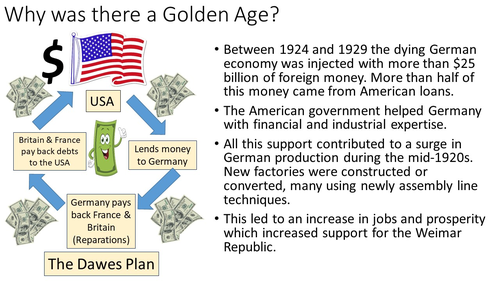



















This beautifully designed lesson looks at the cultural changes that took place during Germany’s Golden Age in the 1920s and looks at how they were interpreted by different groups. The information is accessible to a range of abilities and can be used alongside a wide range of main stream text books or used as a stand alone resource. Depending upon the teaching and learning styles in your school, you could deliver the lesson or print off the relevant slides on art, cinema, nightlife, literature and design and get your students to complete their notes in a market place or gather and share activity.
When you purchase this resource you will be able to download a PowerPoint presentation entitled Germany’s golden age. The first few slides include, aims, objectives, differentiated out comes and two potential starters. The next few slides then set the scene and put the period into its historical context. This includes a beautifully illustrated and animated diagram on the Dawes Plan. This is followed up with information slides with images and relevant video links on cinema, nightlife, literature, art and design in Germany at this time. These could be used as described above as a gather and share exercise. Once complete the next two slides include tasks and information to help students construct a mind map. In order to extend the more able you could always give out text books to provide additional information that they could use for research.
The next section of the PowerPoint looks at several different sources on how different groups in Germany reacted to this new explosion of culture and this is then followed up with an AQA GCSE History style questions with an AFL pupil mark scheme for the new syllabus. However, if you use a different exam board the mark schemes are fully editable and could be easily customised to suit your exam board.
The Aims & Objectives are:
Theme: Weimar Republic 1923 - 1929
Know: What were the key features of Germany’s Golden Age?
Understand: What cultural changes took place and why did they happen?
Evaluate: How did different people respond to these changes?
Skills: Cause, Consequence & Collaboration
WILF – What Am I Looking For?
Identify & describe: The key features of Germany’s Golden Age
Explain: What cultural changes took place and why did they happen?
Analyse: How did different people respond to these changes?
If you like this resource then why not check out my other resources on this topic in my TES shop. You can also follow ‘The History Academy’ on Twitter, Google Plus, YouTube and Facebook for the latest updates or even to get in touch and chat about how you have used this resource or to ask questions. We aim to produce cheap and affordable resources for either the price of a good cup of coffee so that you can spend more time doing the things that you want.
Anyway, have fun and stay in touch via social media for the latest updates.
Kind Regards
Roy
Get this resource as part of a bundle and save up to 55%
A bundle is a package of resources grouped together to teach a particular topic, or a series of lessons, in one place.
Something went wrong, please try again later.
Report this resourceto let us know if it violates our terms and conditions.
Our customer service team will review your report and will be in touch.
